Large denominations of United States currency
Large denominations of United States currency greater than $100 were circulated by the United States Treasury until 1969. Since then, the U.S. dollar has only been issued in seven denominations: $1, $2, $5, $10, $20, $50, and $100.
Overview and history
Large-denomination currency (i.e., banknotes with a face value of $500 or higher)[1] had been used in the United States since the late 18th century.[2] The first $500 note was issued by the Province of North Carolina, authorized by legislation dated May 10, 1780.[3] Virginia quickly followed suit and authorized the printing of $500 and $1,000 notes on October 16, 1780[4] and $2,000 notes on May 7, 1781.[5] High-denomination treasury notes were issued, for example during the War of 1812 ($1,000 notes authorized by an act dated June 30, 1812).[6] During the American Civil War Confederate currency included $500 and $1,000 notes.[7] During the Federal banknote issuing period (1861 to present), the earliest high-denomination notes included three-year Interest-bearing notes of $500, $1,000, and $5,000, authorized by Congress on July 17, 1861.[8] In total, 11 different types of U.S. currency were issued in high-denomination notes across nearly 20 different series dates. The obverse of United States banknotes generally depict either historical figures, allegorical figures symbolizing significant concepts (e.g., liberty, justice), or a combination of both. The reverse designs range from abstract scroll-work with ornate denomination identifiers to reproductions of historical art works.
Public versus institutional use
Series 1934 gold certificates ($100, $1,000, $10,000 and $100,000) were issued after the gold standard was repealed and gold was compulsorily confiscated by order of President Franklin Roosevelt on March 9, 1933 (see United States Executive Order 6102). Thus the series 1934 notes were used only for intra-government (i.e., Federal Reserve Bank) transactions and were not issued to the public. This series was discontinued in 1940. The series 1928 gold certificate reverse was printed in black and green. See history of the United States dollar.
Passive retirement
Although they are still technically legal tender in the United States, high-denomination bills were last printed on December 27, 1945, and officially discontinued on July 14, 1969, by the Federal Reserve System,[9] due to 'lack of use'. The $5,000 and $10,000 effectively disappeared well before then.[nb 1]
The Federal Reserve began taking high-denomination currency out of circulation (destroying large bills received by banks) in 1969. As of May 30, 2009, only 336 $10,000 bills were known to exist; 342 remaining $5,000 bills; and 165,372 remaining $1,000 bills.[10] Due to their rarity, collectors often pay considerably more than the face value of the bills to acquire them. Some are in museums in other parts of the world.
For the most part, these bills were used by banks and the Federal government for large financial transactions. This was especially true for gold certificates from 1865 to 1934. However, for the most part, the introduction of an electronic money system has made large-scale cash transactions obsolete. When combined with concerns about counterfeiting and the use of cash in unlawful activities such as the illegal drug trade and money laundering, it is unlikely that the U.S. government will re-issue large denomination currency in the near future, despite the amount of inflation that has occurred since 1969 (a $500 bill is now worth less, in real terms, than a $100 bill was worth in 1969). According to the U.S. Department of Treasury website, "The present denominations of our currency in production are $1, $2, $5, $10, $20, $50 and $100. The purpose of the United States currency system is to serve the needs of the public and these denominations meet that goal. Neither the Department of the Treasury nor the Federal Reserve System has any plans to change the denominations in use today."[11]
High-denomination (HD) banknote issuing data
| Abbr | Type | Size[nb 3] | Series dates | High denomination series date | Comments | ||||
|---|---|---|---|---|---|---|---|---|---|
| $500 | $1,000 | $5,000 | $10,000 | $100,000 | |||||
| LT | Legal tender | Large | 1862–1923 | 1862 1863 1869 1874 1875 1878 1880 |
1862 1863 1869 1878 1880 |
1878 | 1878 | – | All Series 1878 $5,000 and $10,000 notes have been redeemed.[14] |
| CITN | Compound interest treasury note | Exception | 1863–1864 | 1863 1864 |
1864 | – | – | – | |
| IBN | Interest bearing note | Exception | 1861–1865 | 1861 1863 1864 1865 |
1861 1863 1864 1865 |
1861 1863 1864 1865 |
– | – | Issued HD IBN are virtually unknown.[nb 4] |
| SC | Silver certificate | Large | 1878–1923 | 1878 1880 |
1878 1880 1891 |
– | – | – | |
| TN | Treasury note | Large | 1890–1891 | 1891[nb 5] | 1890 1891 |
– | – | – | |
| NBN | National bank note | Large | 1865–1875 | 1865 1875 |
1865 1875 |
– | – | – | |
| FRN | Federal reserve note | Large | 1914–1918 | 1918 | 1918 | 1918 | 1918 | – | |
| NGBN | National gold bank note | Large | 1870–1883 | 1870[nb 6] | –[nb 7] | – | – | – | No issued notes or proofs exist of either $500 or $1,000 NGBN |
| GC | Gold certificate | Large[nb 8] | 1865–1922 | 1865 1870 1875 1882 1922 |
1865 1870 1875 1882 1907 1922 |
1865 1870 1882 1888 |
1865 1870 1875 1882 1888 1900 |
– | |
| FRN | Federal reserve note | Small | 1928–present | 1928 1934 |
1928 1934 |
1928 1934 |
1928 1934 |
– | |
| GC | Gold certificate | Small | 1928–1934[nb 9] | 1928 | 1928 1934 |
1928 | 1928 1934 |
1934 | |
High-denomination United States banknotes
The National Numismatic Collection at the Smithsonian Institution contains (among other things) the Bureau of Engraving and Printing (BEP) certified proofs and the Treasury Department collection of United States currency. Using a combination of proofs and issued notes, a nearly complete type set of high-denomination currency was compiled. Notably missing are several types of Compound and Interest Bearing Notes. Printed during the early to mid-1860s on very thin paper, these high-denomination notes are virtually non-existent. Their issuance (1861–65) pre-dates the BEP's responsibility for U.S. Currency (1870s), so it is fortunate that any proofs exist in the current archives.
| Value | Type | Series | Fr. | Image | Portrait/engraving[nb 11] | Comments[nb 12] |
|---|---|---|---|---|---|---|
| $500 | LT | 1862–63 | Fr.183c | 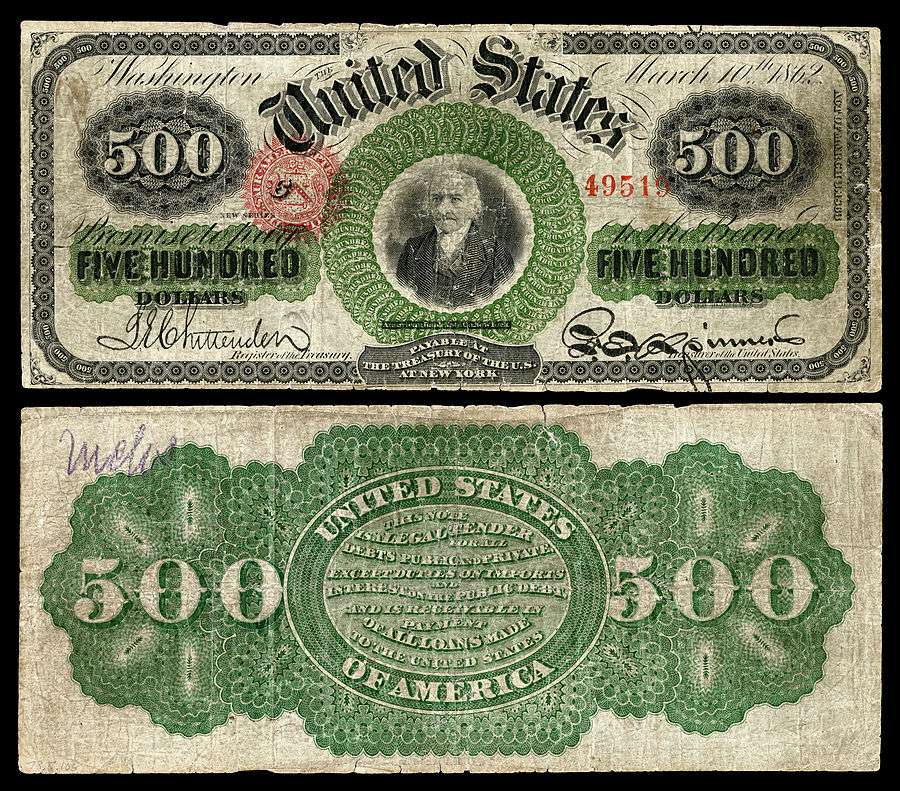 |
Albert Gallatin | 4 known (variety) 7 known (type)[18] |
| $500 | LT | 1869 | Fr.184 |  |
John Quincy Adams (Charles Burt)[19] Justice (Stephen A. Schoff)[20] |
4 known (only one privately)[21] |
| $500 | LT | 1874–78 | Fr.185b |  |
Joseph Mansfield (Charles Burt)[19] Victory (Charles Burt)[22] |
|
| $500 | LT | 1880 | Fr.185l |  |
Joseph Mansfield (Charles Burt)[19] Victory (Charles Burt)[22] |
5 known (variety)[nb 13] |
| $500 | CITN | 1864 | Fr.194a Proof |
.jpg) |
Standard Bearer (left) (George D. Baldwin)[24] New Ironsides (right) (James Smillie)[25] |
Unknown[26] |
| $500 | SC | 1878 | Fr.345a |  |
Charles Sumner (Charles Burt)[19] |
Unique (variety and type)[27] |
| $500 | SC | 1880 | Fr.345c |  |
Charles Sumner (Charles Burt)[19] |
5 known (variety) 7 known (type)[27] |
| $500 | TN | 1891 | Fr.379 Proof |
 |
William Tecumseh Sherman | None issued[28] |
| $500 | NBN | 1865–75 | Fr.464 |  |
Civilization (left) (James D. Smillie)[29] Sirius arriving in New York (right) Surrender of General Burgoyne (rev) (Frederick Girsch)[30] |
2 known (variety) 3 known (type)[31] |
| $500 | FRN | 1918 | Fr.1132d |  |
John Marshall (Charles Schlecht)[32] de Soto discovering the Mississippi (rev) (Frederick Girsch)[30] |
|
| $500 | GC | 1863 | Fr.1166d Proof |
.jpg) |
Eagle with shield or E Pluribus Unum (Charles Skinner)[33] |
Unknown[34] |
| $500 | GC | 1870–75 | Fr.1166i |  |
Abraham Lincoln (Charles Burt)[19] |
Unique[34] |
| $500 | GC | 1882–1922 | Fr.1216a |  |
Abraham Lincoln (Charles Burt)[19] |
|
| $500 | FRN | 1928–34 | Fr.2200g |  |
William McKinley (John Eissler)[35] |
|
| $500 | GC | 1928 | Fr.2407 |  |
William McKinley (John Eissler)[35] |
|
| $1,000 | LT | 1862–63 | Fr.186e |  |
Robert Morris (Charles Schlecht)[32] |
Unique (variety) 5 known (type)[36] |
| $1,000 | LT | 1869 | Fr.186f Proof |
DeWitt Clinton | 2 known[37] | |
| $1,000 | LT | 1878 | Fr.187a |  |
DeWitt Clinton Columbus in his study (Henry Gugler)[38] |
|
| $1,000 | LT | 1880 | Fr.187k |  |
DeWitt Clinton Columbus in his study (Henry Gugler)[38] |
4 known (variety) ~20–25 known (type)[nb 14] |
| $1,000 | IBN | 1863 | Fr.201 Proof |
.jpg) |
Justice (left); Liberty (right) | Unknown[39] |
| $1,000 | IBN | 1863 | Fr.206 Proof |
.jpg) |
Guerriere and the Constitution (left) and Discovery of the Mississippi by De Soto (right) | Unknown[40] |
| $1,000 | SC | 1878 | Fr.346a Proof |
 |
William Marcy (Charles Schlecht)[32] |
Unknown[41] |
| $1,000 | SC | 1880 | Fr.346d | 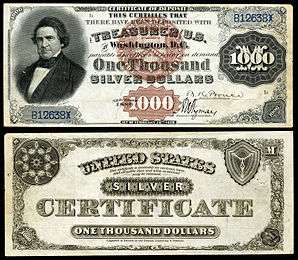 |
William Marcy (Charles Schlecht)[32] |
5 known (variety) 5 known (type)[41] |
| $1,000 | SC | 1891 | Fr.346e | 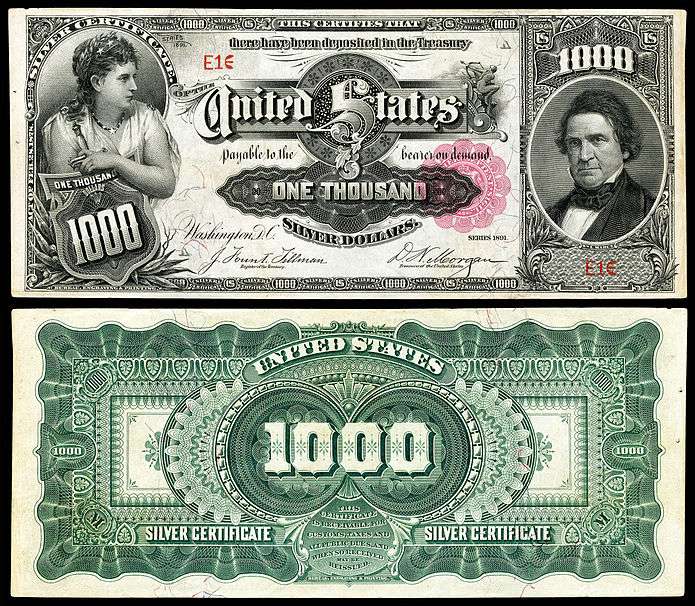 |
William Marcy (Charles Schlecht)[32] Liberty (Charles Burt)[42] |
2 known[41] |
| $1,000 | TN | 1890 | Fr.379a |  |
George Meade (Charles Burt)[19] |
5 known (variety) 7 known (type)[43] |
| $1,000 | TN | 1891 | Fr.379c | 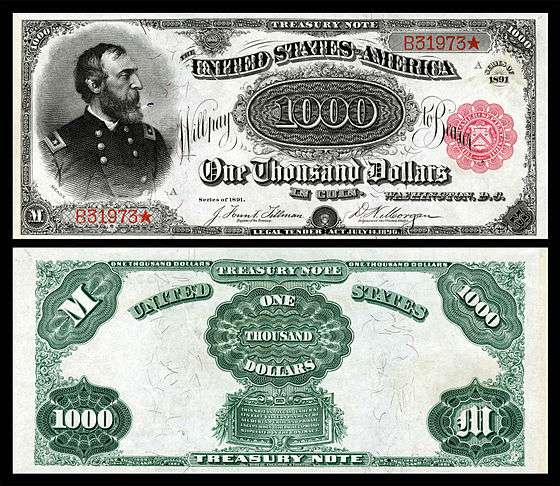 |
George Meade (Charles Burt)[19] |
2 known (variety) 3 known (type)[43] |
| $1,000 | NBN | 1865–75 | Fr.465 Proof |
.jpg) |
Scott entering City of Mexico (left) (Alfred Jones)[44] United States Capitol (right) (James Smillie)[25] Washington resigning his commission (rev) (Frederick Girsch)[30] |
Unknown[45] |
| $1,000 | FRN | 1918 | Fr.1133d |  |
Alexander Hamilton (G.F.C. Smillie)[46] Eagle (rev) (Marcus W. Baldwin)[47] |
|
| $1,000 | GC | 1863 | Fr.1166e Proof |
.jpg) |
Eagle with shield or E Pluribus Unum (Charles Skinner)[33] Justice with scales |
Unique[34] |
| $1,000 | GC | 1870–75 | Fr.1166o Proof |
 |
Alexander Hamilton (Charles Burt)[48] |
Unique[34] |
| $1,000 | GC | 1882 | Fr.1218g |  |
Alexander Hamilton (G.F.C. Smillie)[46] |
|
| $1,000 | GC | 1907–22 | Fr.1219 | 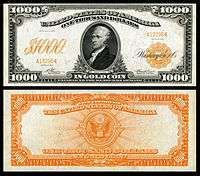 |
Alexander Hamilton | |
| $1,000 | FRN | 1928–34 | Fr.2210g |  |
Grover Cleveland (John Eissler)[35] |
|
| $1,000 | GC | 1928 | Fr.2408 |  |
Grover Cleveland (John Eissler)[35] |
|
| $1,000 | GC | 1934 | Fr.2409 |  |
Grover Cleveland (John Eissler)[35] |
|
| $5,000 | LT | 1878 | Fr.188 Proof |
 |
James Madison (Alfred Sealey)[49] Eagle (William Chorlton)[50] |
All notes have been redeemed, none outstanding[14] |
| $5,000 | IBN | 1863 | Fr.202 Proof |
.jpg) |
The Altar of Liberty (Louis Delnoce)[51] |
Unknown[39] |
| $5,000 | IBN | 1865 | Fr.212h Proof |
.jpg) |
Justice (left) New Ironsides (center) (James Smillie)[25] |
|
| $5,000 | FRN | 1918 | Fr.1134d |  |
James Madison (Alfred Sealey)[52] Washington resigning his commission (rev) (Louis Delnoce)[51] |
Unique (variety) 5 known (type)[nb 15] |
| $5,000 | GC | 1863 | Fr.1166f Proof |
.jpg) |
Eagle with shield or E Pluribus Unum (Charles Skinner)[33] Female |
Unique[34] |
| $5,000 | GC | 1870–75 | Fr.1166k Proof |
 |
James Madison (Alfred Sealey)[48] |
Unknown[34] |
| $5,000 | GC | 1882 | Fr.1221a Proof |
 |
James Madison (Alfred Sealey)[54] |
Two known[34] |
| $5,000 | FRN | 1928–34 | Fr.2220g |  |
James Madison (Alfred Sealey)[54] |
|
| $5,000 | GC | 1928 | Fr.2410 |  |
James Madison | |
| $10,000 | LT | 1878 | Fr.189 Proof |
 |
Andrew Jackson (Alfred Sealey)[55] |
All notes have been redeemed, none outstanding[14] |
| $10,000 | FRN | 1918 | Fr.1135d |  |
Salmon Chase; Embarkation of the Pilgrims (rev) | Unique (variety) 5 known (type)[nb 16] |
| $10,000 | GC | 1863 | Fr.1166g Proof |
.jpg) |
Eagle with shield or E Pluribus Unum (Charles Skinner)[33] |
Unknown[34] |
| $10,000 | GC | 1870–75 | Fr.1166l Proof |
 |
Andrew Jackson | Unique[34] |
| $10,000 | GC | 1882 | Fr.1223a Proof |
 |
Andrew Jackson (Alfred Sealey)[54] |
Two known[34] |
| $10,000 | GC | 1900 | Fr.1225 |  |
Andrew Jackson (Alfred Sealey)[54] |
|
| $10,000 | FRN | 1928–34 | Fr.2230b |  |
Salmon P. Chase | |
| $10,000 | GC | 1928 | Fr.2411 |  |
Salmon P. Chase | |
| $10,000 | GC | 1934 | Fr.2412 |  |
Salmon P. Chase | |
| $100,000 | GC | 1934 | Fr.2413 | 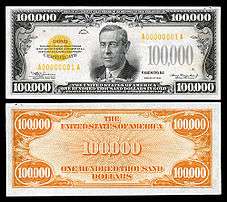 |
Woodrow Wilson (G.F.C. Smillie)[46] Reverse (Frederick Pauling)[56] |
|
See also
- Currency of the United States
- Gold certificate
- Fake denominations
- Silver certificate (United States)
- Silver standard
- Treasury Note (1890–91)
References
Footnotes
- ↑ One hundred $10,000 bills were on display for many years by Benny Binion at Binion's Horseshoe casino in Las Vegas, Nevada, where they were encased in acrylic. The display has since been dismantled and the bills sold to private collectors.
- ↑ The following types of United States banknotes were not issued in high denominations and are not included in the list below: Demand notes, Federal Reserve bank notes (large or small size), legal tender (small size), silver certificates (small size), National Bank Notes (small size)[12] The table sections are sorted by their appearance in the Friedberg reference book.
- ↑ Large size notes represent the earlier types or series of U.S. banknotes. Their "average" dimension is 7 3⁄8 × 3 1⁄8 inches (187 × 79 mm). Small size notes (described as such due to their size relative to the earlier large size notes) are an "average" 6 1⁄8 × 2 5⁄8 (156 × 67 mm), the size of modern U.S. currency. "Each measurement is ± 0.08 inches (2 mm) to account for margins and cutting".[13] Exceptions to the large versus small categories are the CITN, IBN, and RC, all slightly larger than the large size note dimensions.
- ↑ There may be one $500 and 2–3 $1,000 known from all issue dates.[15]
- ↑ A $500 Series 1891 Treasury Note was authorized and a certified proof was prepared, but the note was never issued.[16]
- ↑ Three banks issued $500 NBGN. None are reported, only four notes have not been redeemed.
- ↑ The Kidder National Gold Bank of Boston received two-note $500–$1,000 sheets from the Treasury. The bank returned the shipment intact.
- ↑ Despite the authorizing act date of 3 March 1863, Gold certificates were not issued until 1865.[17]
- ↑ Series 1934 Gold certificates were never intended for public circulation.
- ↑ The table is sorted by denomination and then by Friedberg number.
- ↑ When the information is available, the engraver's name has been added in parentheses. Column sorting is based on the individual depicted in the portrait.
- ↑ Variety is the Friedberg number, or specific combination of signatures and seal type; type represents all the varieties that exist for a given denomination and design, it is the total number of note known for the entire design type.
- ↑ Of the 5 known notes, 4 are in institutional collections.[23]
- ↑ Of the 4 known notes, 2 are in institutional collections.[23]
- ↑ None exist outside of institutional collections.[53]
- ↑ None exist outside of institutional collections.[53]
Notes
- ↑ Friedberg & Friedberg, 2013, pp. 232–35.
- ↑ Friedberg & Friedberg, 2013, p. 22.
- ↑ Newman, 2008, p. 326.
- ↑ Newman, 2008, p. 454.
- ↑ Newman, 2008, p. 455.
- ↑ Friedberg & Friedberg, 2013, p. 32.
- ↑ Fricke, 2014, p. 122 & 124.
- ↑ United States Congress. Act of July, 17 1861 Chapter Ⅴ. Washington D.C.: 1861
- ↑ "Large denominations". Bureau of Engraving and Printing/Treasury Website. Retrieved 20 June 2014.
- ↑ Palmer, Brian (July 24, 2009). "Somebody Call Officer Crumb!: How much cash can a corrupt politician cram into a cereal box?". Slate.com. Retrieved July 24, 2012. As to "cereal boxes" as a repository for ill-gotten bribes compare "Little Tin Box" in the musical Fiorello!.
- ↑ our Treasury – FAQs: Denominations of Currency.
- ↑ Friedberg & Friedberg, 2013, generally.
- ↑ Friedberg, p. 7.
- 1 2 3 Friedberg & Friedberg, 2013, p. 58.
- ↑ Friedberg & Friedberg, 2013, p. 72.
- ↑ Friedberg & Friedberg, 2013, p. 91.
- ↑ Friedberg & Friedberg, 2013, p. 164.
- ↑ Friedberg & Friedberg, 2013, p. 54.
- 1 2 3 4 5 6 7 8 9 Hessler, 1993, pp. 71–73.
- ↑ Hessler, 2004, p. 36.
- ↑ Friedberg & Friedberg, 2013, p. 55.
- 1 2 Hessler, 2004, p. 38.
- 1 2 "Heritage Auctions (#3521) 2013 January 9–14 FUN Signature Auction". HA.com. Retrieved 24 June 2014.
- ↑ Hessler, 1993, p. 38.
- 1 2 3 Hessler, 1993, p. 286.
- ↑ Friedberg & Friedberg, 2013, p. 61.
- 1 2 Friedberg & Friedberg, 2013, p. 89.
- ↑ Friedberg & Friedberg, 2013, p. 97.
- ↑ Hessler, 1993, p. 290.
- 1 2 3 Hessler, 1993, p. 137.
- ↑ Friedberg & Friedberg, 2013, p. 109.
- 1 2 3 4 5 Hessler, 1993, p. 265.
- 1 2 3 4 Hessler, 2004, p. 216.
- 1 2 3 4 5 6 7 8 9 10 Friedberg & Friedberg, 2013, p. 165.
- 1 2 3 4 5 Hessler, 1993, p. 114.
- ↑ Friedberg & Friedberg, 2013, p. 56.
- ↑ Friedberg & Friedberg, 2013, p. 57.
- 1 2 Hessler, 1993, p. 145.
- 1 2 Friedberg & Friedberg, 2013, p. 64.
- ↑ Friedberg & Friedberg, 2013, p. 66.
- 1 2 3 Friedberg & Friedberg, 2013, pp. 89–90.
- ↑ Hessler, 2004, p. 95.
- 1 2 Friedberg & Friedberg, 2013, p. 98.
- ↑ Hessler, 1993, p. 180.
- ↑ Friedberg & Friedberg, 2013, p. 110.
- 1 2 3 Hessler, 1993, p. 280.
- ↑ Hessler, 1993, p. 40.
- 1 2 Hessler, 2004, p. 219.
- ↑ Hessler, 2004, p. 39
- ↑ Hessler, 1993, p. 83.
- 1 2 Hessler, 1993, p. 99.
- ↑ Hessler, 2004, p. 200.
- 1 2 Friedberg & Friedberg, 2013, p. 159.
- 1 2 3 4 Hessler, 2004, p. 223.
- ↑ Hessler, 2004, p. 39.
- ↑ Hessler, 1993, p. 237.
Bibliography
- Fricke, Pierre (2014). Collecting Confederate Paper Money. Pierre Fricke. ISBN 978-0-9844534-9-8.
- Friedberg, Arthur L.; Friedberg, Ira S. (2013). Paper Money of the United States: A Complete Illustrated Guide With Valuations (20th ed.). Coin & Currency Institute. ISBN 978-0-87184-520-7. Retrieved 14 February 2014.
- Hessler, Gene (1993). The Engraver's Line – An Encyclopedia of Paper Money & Postage Stamp Art. BNR Press. ISBN 0-931960-36-3.
- Hessler, Gene (2004). U.S. Essay, Proof and Specimen Notes (2 ed.). BNR Press. ISBN 0-931960-62-2.
- Huntoon, Peter W. (1995). United States Large Size National Bank Notes. Society of Paper Money Collectors, Inc. ISBN 0-9648774-1-4.
- Newman, Eric P. (2008). The Early Paper Money of America (5 ed.). Krause Publications. ISBN 0-89689-326-X.
- Schwartz, John; Lindquist, Scott (2011). Standard Guide to Small-Size U.S. Paper Money – 1928 to Date. Krause Publications. ISBN 978-1-4402-1703-6. Retrieved 14 February 2014.
External links
 Media related to Money of the United States by denomination at Wikimedia Commons
Media related to Money of the United States by denomination at Wikimedia Commons- Large Denominations from the Bureau of Engraving and Printing
- U.S. Department of the Treasury